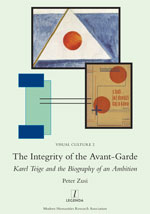The Integrity of the Avant-Garde
Karel Teige and the Biography of an Ambition
Peter Zusi
Click cover to enlarge Booksellers & libraries: | Legenda
ISBN: 978-1-839541-66-7 (hardback) • RRP £85, $115, €99 ISBN: 978-1-839541-67-4 (paperback, forthcoming) ISBN: 978-1-839541-68-1 (JSTOR ebook) On what grounds do we speak of ’the avant-garde’ in interwar European culture? Why do we understand the conflicts and quarrels among these diverse movements as expressing a shared attitude—the culture of the manifesto, the drive to reject, to explore, to renew—that trumps the conflicts and quarrels themselves? Why do the stern rationalism of a functionalist building and the irreverent irrationalism of a Dadaist performance seem heralds of a similar spirit? The Czech avant-garde art theorist Karel Teige (1900-1951) regarded architecture and film as providing the key to formulating a unified theory that would capture this ‘integrity of the avant-garde’. Teige—whose thought has many points of contact with celebrated figures such as Georg Lukács and Walter Benjamin, and who was a close associate of Le Corbusier, André Breton, and Hannes Meyer—reveals how a vibrant ‘alternative’ avant-garde tradition can raise central questions for understanding European modernism. Peter Zusi is Associate Professor of Czech and Comparative Literature at the School of Slavonic and East European Studies, University College London.
Bibliography entry: Zusi, Peter, The Integrity of the Avant-Garde: Karel Teige and the Biography of an Ambition, Visual Culture, 2 (Legenda, 2024) First footnote reference: 35 Peter Zusi, The Integrity of the Avant-Garde: Karel Teige and the Biography of an Ambition, Visual Culture, 2 (Legenda, 2024), p. 21. Subsequent footnote reference: 37 Zusi, p. 47. (To see how these citations were worked out, follow this link.) Bibliography entry: Zusi, Peter. 2024. The Integrity of the Avant-Garde: Karel Teige and the Biography of an Ambition, Visual Culture, 2 (Legenda) Example citation: ‘A quotation occurring on page 21 of this work’ (Zusi 2024: 21). Example footnote reference: 35 Zusi 2024: 21. (To see how these citations were worked out, follow this link.) This title is distributed on behalf of MHRA by Ingram’s. Booksellers and libraries can order direct from Ingram by setting up a free ipage® Account: click here for more. Permanent link to this title: www.mhra.org.uk/publications/Integrity-Avant-Garde www.mhra.org.uk/publications/vc-2 |


 18 March 2024 • 320pp
18 March 2024 • 320pp